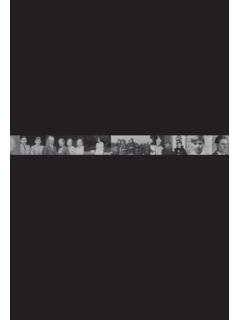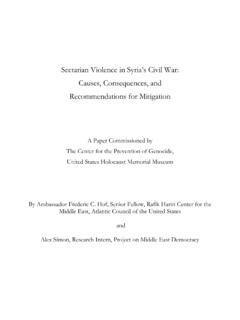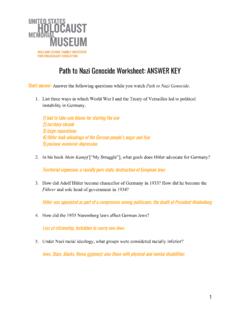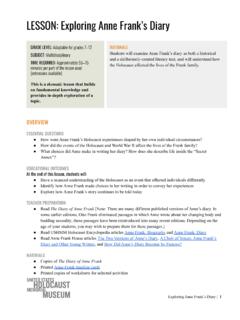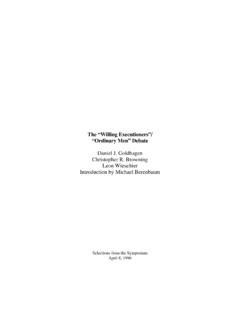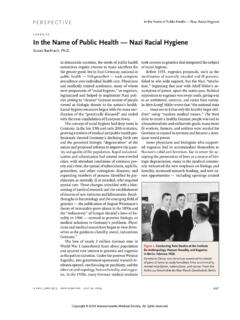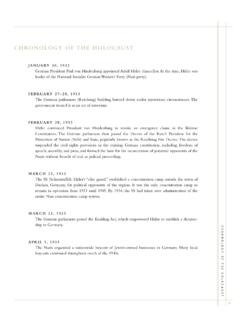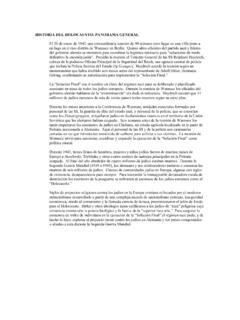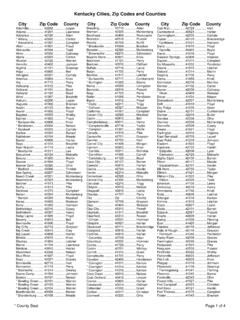Transcription of ELIE WIESEL - United States Holocaust Memorial Museum
1 ELIE WIESELUNITED States Holocaust Memorial MUSEUMUNITED States Holocaust Memorial MUSEUMSEPTEMBER 30, 1928 ELIE WIESEL BORN Elie WIESEL was born to a religious Jewish family in the town of Sighet, which was in the Transylvanian region of Romania. WIESEL had two older sisters and one younger sister. This postcard shows the main market square in Sighet before World War WIESELUNITED States Holocaust Memorial MUSEUMJANUARY 30, 1933 ADOLF HITLER APPOINTED CHANCELLOR OF GERMANY German president Paul von Hindenburg appointed Adolf Hitler, the head of the National Socialist German Workers (Nazi) Party, to be chancellor of Germany. In the spring of 1933, Nazi Party supporters attacked Jews on the streets of Germany, boycotted Jewish-owned stores, and burned books. The WIESEL family lived hundreds of miles away and was not affected by the early Nazi persecution of German Jews.
2 ELIE WIESELUNITED States Holocaust Memorial MUSEUMSEPTEMBER 15, 1935 REICH CITIZENSHIP LAW The Nuremberg Race Laws set a legal definition for which people the German government considered to be Jewish. Under the law, German Jews lost their citizenship and were also forbidden from entering into relationships with non-Jews. This chart helped explain the law to Germans. Sighet was not part of Germany, so the WIESEL family was not affected by these laws. ELIE WIESELUNITED States Holocaust Memorial MUSEUMNOVEMBER 9 10, 1938 KRISTALLNACHT ATTACKS Nazi supporters launched a coordinated and violent attack against Jews in the areas controlled by Germany. They burned hundreds of synagogues, destroyed stores and homes owned by Jewish families, and arrested 30,000 Jewish men and boys who were then imprisoned in concentration camps.
3 Sighet was not controlled by Germany at this time, and Elie WIESEL was not affected by these WIESELUNITED States Holocaust Memorial MUSEUM1938 39 ANTISEMITISM IN ROMANIA Romanian authorities pursued a harsh policy of antisemitism, encouraged by members of the fascist Iron Guard movement, who wanted to expel Jews from Romania. As a child, Elie WIESEL witnessed Jews being attacked on the streets and saw antisemitic graffiti on buildings. Even though WIESEL was not living under Nazi control, he still experienced antisemitism. This is a photo of Vicky Hershkovits, who lived with her family in Bixad, Romania, 40 miles from WIESEL s hometown of Sighet. In the late 1930s, her father s bus company was taken away because he was Jewish. ELIE WIESELUNITED States Holocaust Memorial MUSEUMSEPTEMBER 1, 1939 GERMANY INVADES POLAND Nazi Germany invaded Poland.
4 Great Britain and France, which had an alliance with Poland, declared war on Germany. World War II officially began. Elie WIESEL later wrote, We were at war, but I did not feel threatened. For me life went on as before. ELIE WIESELUNITED States Holocaust Memorial MUSEUMMAY 10, 1940 GERMANY INVADES WESTERN EUROPE The German military invaded and occupied the Netherlands, Belgium, and Luxembourg. They also invaded France, dividing it into Nazi-occupied and Nazi-aligned zones. Thousands of foreign Jews were rounded up and sent to concentration camps in southern France. ELIE WIESELUNITED States Holocaust Memorial MUSEUMJUNE 14, 1940 FIRST PRISONERS ARRIVE AT AUSCHWITZ The SS opened a large concentration camp called Auschwitz near the town of O wi cim in Nazi-occupied Poland. The first prisoners of Auschwitz were German and Polish men (both Christian and Jewish).
5 Most of them were imprisoned as political opponents of the Nazis. This mugshot shows 18-year-old Zbigniew Matys, a Polish prisoner. He was prisoner number WIESELUNITED States Holocaust Memorial MUSEUMAUGUST 30, 1940 SIGHET GIVEN TO HUNGARY Nazi Germany forced Romania to give up territory. Transylvania, including the area of Sighet--where the WIESEL family lived--was granted to Hungary. Hungarian race laws, passed between 1938 and 1941, classified the WIESEL family as Jewish and took away many of their rights. This map appeared in American WIESELI ndianapolis Star, courtesy States Holocaust Memorial MUSEUMNOVEMBER 20, 1940 HUNGARY JOINS THE AXIS Hungary joined the Axis powers, a group of countries aligned with Nazi Germany. Thousands of Jewish men in Hungarian territory (which by then included Sighet, where the Wiesels lived) were forced to join labor battalions doing war-related construction.
6 Many, including most of the men in this picture, died. ELIE WIESELUNITED States Holocaust Memorial MUSEUMJUNE 22, 1941 GERMANY INVADES THE SOVIET UNIONELIE WIESEL Breaking an August 1939 non-aggression pact, Nazi Germany launched a surprise invasion of the Soviet Union and the areas occupied by the Soviet Union (including Lithuania, Latvia, and Estonia). Hungarian troops aided in the invasion. Mobile killing squads (Einsatzgruppen) followed behind the German lines, murdering Jews and other victims by shooting them and gassing them in gas vans. Approximately two million Jews died this States Holocaust Memorial MUSEUMJULY AUGUST 1941 FOREIGN JEWS DEPORTED FROM HUNGARY Hungarian authorities rounded up and deported approximately 30,000 foreign Jews who could not prove Hungarian citizenship. In late August 1941, Einsatzgruppen units murdered most of these Jews in Kamenets-Podolsk, a city in western Ukraine.
7 This photograph shows Jews at the killing site. Only a few escaped, including a man WIESEL called Moshe the Beadle, who returned to Sighet and warned the Jews living there of the massacres. ELIE WIESELUNITED States Holocaust Memorial MUSEUMDECEMBER 7, 1941 United States ENTERS WORLD WAR II The Japanese military launched a surprise attack on the US Pacific fleet at Pearl Harbor, Hawaii. The United States declared war on Japan. On December 11, Nazi Germany declared war on the United States . The United States officially entered World War II and joined the WIESELUNITED States Holocaust Memorial MUSEUMDECEMBER 8, 1941 MASS MURDER BEGINS AT CHE MNO The SS and Nazi police authorities opened the Chelmno killing center to murder Jews, Poles, Soviet prisoners of war, and Roma in Nazi-occupied Poland.
8 Che mno was the first stationary facility where the Nazis used poison gas for mass murder. At least 172,000 people were murdered at Che mno. These toys were excavated from the grounds of Che WIESELUNITED States Holocaust Memorial MUSEUMJANUARY 20, 1942 WANNSEE CONFERENCE German government officials and Nazi Party officials held a conference at the Wannsee Villa in a suburb of Berlin. They discussed the logistics of the Final Solution. The Final Solution was a code name for the mass murder of European Jews. The mass murder of Jews had already begun by the time the conference took place. At the Wannsee conference, the Nazis discussed how to coordinate the expansion of the WIESELUNITED States Holocaust Memorial MUSEUMMARCH 17, 1942 OPERATION REINHARD BEGINS Operation Reinhard was the code name for the plan to murder approximately two million Jews in the Generalgouvernment, or German-occupied Poland.
9 They opened three killing centers: Treblinka, Belzec, and Sobibor. At least million Jews were murdered in these centers. The Belzec killing center began gassings on this WIESELUNITED States Holocaust Memorial MUSEUMDECEMBER 17, 1942 ALLIES CONDEMN MASS MURDER News of the Final Solution was reported in American newspapers in late November 1942. The United States , Great Britain, Soviet Union, and other Allied governments issued a declaration condemning the Nazi policy of cold-blooded extermination and promised to punish the perpetrators after the war. ELIE WIESELUNITED States Holocaust Memorial MUSEUMFEBRUARY 2, 1943 GERMANS DEFEATED AT STALINGRAD The German military surrendered after battling for seven months to capture the Soviet city of Stalingrad (now Volgograd). The Soviet victory at the battle of Stalingrad marked a turning point in World War II.
10 Soviet forces began to push the German military back. ELIE WIESELUNITED States Holocaust Memorial MUSEUMAPRIL 19, 1943 WARSAW GHETTO UPRISING BEGINS In summer 1942, Nazi authorities deported approximately 300,000 Jews from the Warsaw Ghetto and murdered them in the Treblinka killing center. When German troops entered the ghetto to deport the remaining Jews, armed Jewish resistance fighters attacked. The Nazis greatly outnumbered them. Jews in the Warsaw Ghetto fought for nearly a month using makeshift weapons before they were defeated by the Nazis. ELIE WIESELUNITED States Holocaust Memorial MUSEUMOCTOBER 14, 1943 SOBIBOR UPRISING Prisoners at the Sobibor killing center launched an uprising, killing a dozen German and Ukrainian guards. Three hundred prisoners escaped the camp; 58 of them, including these men, survived the Holocaust .
